10 Most Famous Cubist Paintings
Cubism is an art movement that drastically inverse the international landscape of art and has also likely created the nearly influence on the modern art styles of today. The overall impact of cubism has reached farther than painting and deep into sculpture, also equally mod compages and other forms of design.
Cubism began roughly at the start of the 20th century as painters dabbled with diverse geometric shapes that were aimed at creating a new, unique way of achieving three-dimensional works of art. Some of the nearly famous painters of the Cubism move were well-known names like Pablo Picasso, Paul Cézanne, and Georges Braque.
Some of the near famous works of fine art from the cubism genre have had a lasting bear on on art every bit a whole. Beneath are 10 of the near famous paintings of the cubist move.
Famous Cubist Paintings
ane. Les Demoiselles d'Avignon – Pablo Picasso
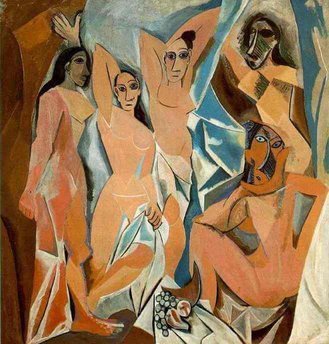
Pablo Picasso is perhaps the well-nigh famous painter of the 20th century with a number of popular works that are widely considered to be masterpieces—specially in the cubist style of painting.
His work titled Les Demoiselles d'Avignon is among the most recognizable paintings in the cubism way and was originally known as The Brothel of Avignon.
Nevertheless, the striking prototype of 5 naked women was non likely to be well received in 1907 Kingdom of spain, prompting him to slightly alter its name to a more appropriate option.
The piece of work features sharp angled images of 5 women whose faces appear to be strangely familiar to those among artwork from Africa. The painting's composition is well balanced with a high level of contrast between vibrant blood-red and blueish colors on either side of the canvas.
Picasso employed the use of irregular geometric shapes to portray the human form in a way that was drastically different from most other artists who relied heavily on producing paintings that were as realistic every bit possible.
His unique style earned him a healthy reputation among art lovers and critics of the day and would lead him down the path of further exploration in the new and captivating genre of cubism.
ii. Woman with a Mandolin – Georges Braque
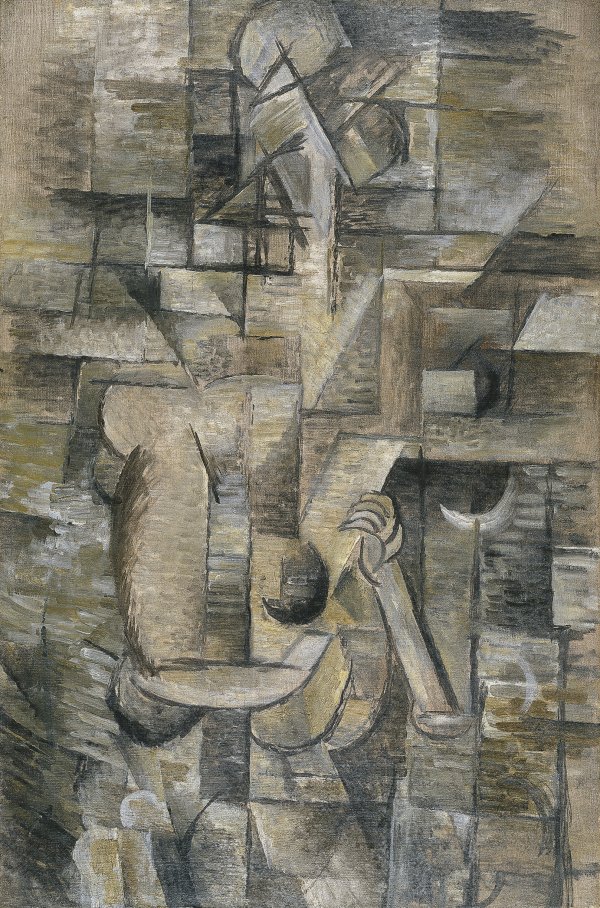
Georges Braque began to venture into the realm of cubism in the early 1900's, painting the work titled Adult female with a Mandolin in 1910.
Braque was especially interested in artwork which featured subjects and musical instruments as the two mediums of art and music are closely related in their power to evoke emotion from humans.
In this piece of work, the creative person combines an interesting level of vertical and horizontal lines to create the figure of a woman. The shadowy geometric shapes and combinations are painted with a variety of gray and darker ochres that seem to draw the viewer in curiously closer to the woman equally she is portrayed strumming the mandolin.
Many art critics run across the mandolin as largely symbolic and representative of a woman'due south womb.
iii. Harlequin with Guitar – Juan Gris
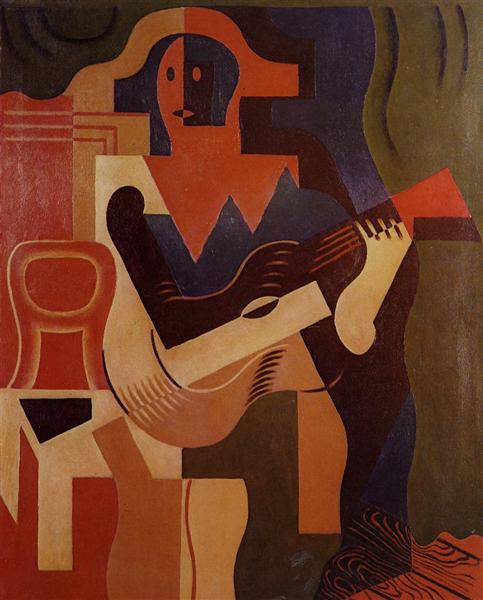
Many cubist artists chose to use a harlequin, or a figure who tin can be closely compared to a pantomime that originated from 16th century theater, in their works.
Juan Gris employed ane such subject field in his piece of work titled Harlequin with Guitar which is among the most famous cubist paintings in history.
The harlequin is easily recognizable as Gris depicts him wearing a traditional checker-patterned costume, and is viewed as a whimsical character that's both attractive and unpredictable.
Painted in 1917, Gris would later delve deep into the use of harlequins in his works of cubist art, creating more than 40 works of similar nature throughout much of the next decade.
The painting is known for the utilise of sharp, angling linear shapes that seem to brand up the seated harlequin'southward figure. Gris' use of varying shades adds a deeper level of item to this painting and is 1 of the virtually easily recognized works in the genre of cubism.
4. Guernica – Pablo Picasso

Many artists in the 20th century drew inspiration from the ever-irresolute earth around them, especially those who were caught up in the horrors of state of war. Pablo Picasso devoted dozens of works to the events that transpired during the Spanish Civil War in which the country was forever changed past seemingly unending mortality.
Also Read: Famous Picasso Paintings
Completed in 1937, his work titled Guernica was immediately famous every bit i of the nearly unique and stark depictions of the war. The painting shows diverse figures who are all affected by the terrible events of the fighting that raged on during the time in which Picasso painted the masterpiece.
It is featured on a giant canvas, which further creates a sense of overwhelming death and destruction in the viewer by Picasso's utilize of grey and black colors.
v. L'Oiseau bleu – Jean Metzinger
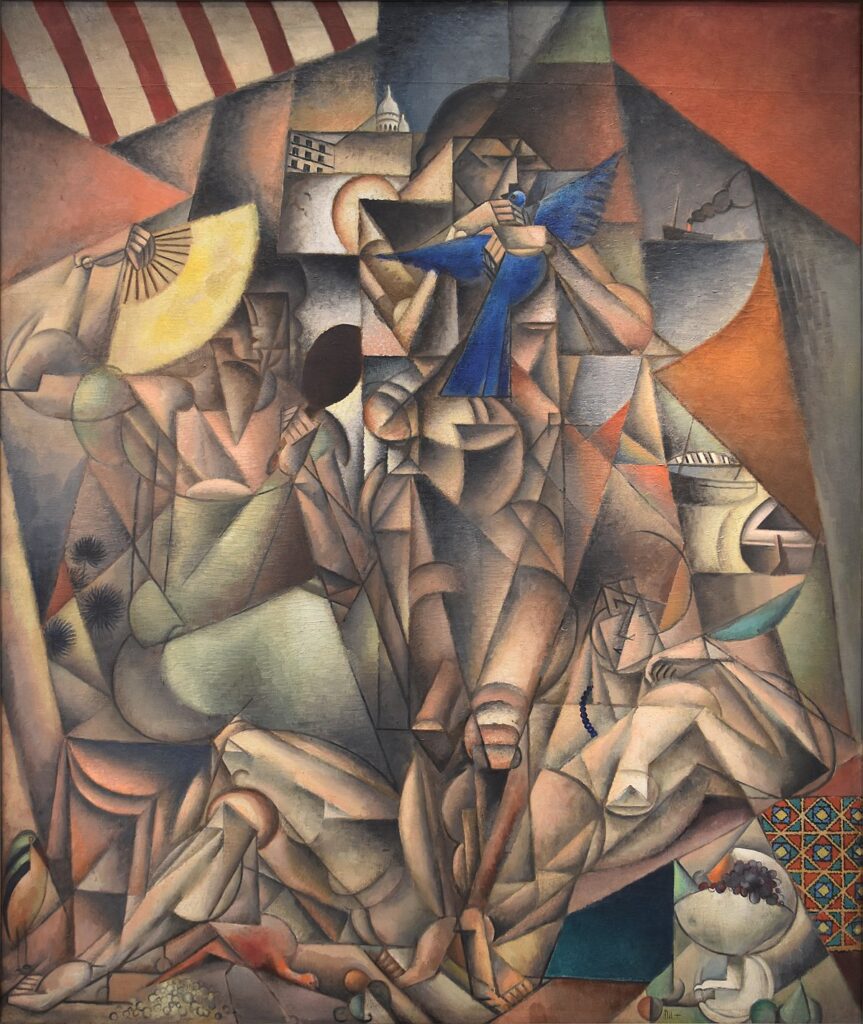
Few artists were able to accomplish as much captivating portrayals of reality through cubism as Jean Metzinger.
His piece of work titled The Blue Bird was painted on a large canvas and featured varying levels of shaded figures that draws the viewer into an otherworldly sense of reality.
Metzinger painted the L'Oiseau bleu, as information technology is known in France, as a pursuit of higher levels of being.
The painting incorporates shapes that are combined on a mathematical level of genius, equally well as Riemannian geometry that comes together to create an exceptionally vibrant scene of cubist mastery.
As well Read: Bird Paintings
Many fine art critics and enthusiasts agree that the painting is the most easily recognizable works done past Metzinger and is a pillar among the greatest cubist artworks in history.
six. Man with a Guitar – Georges Braque
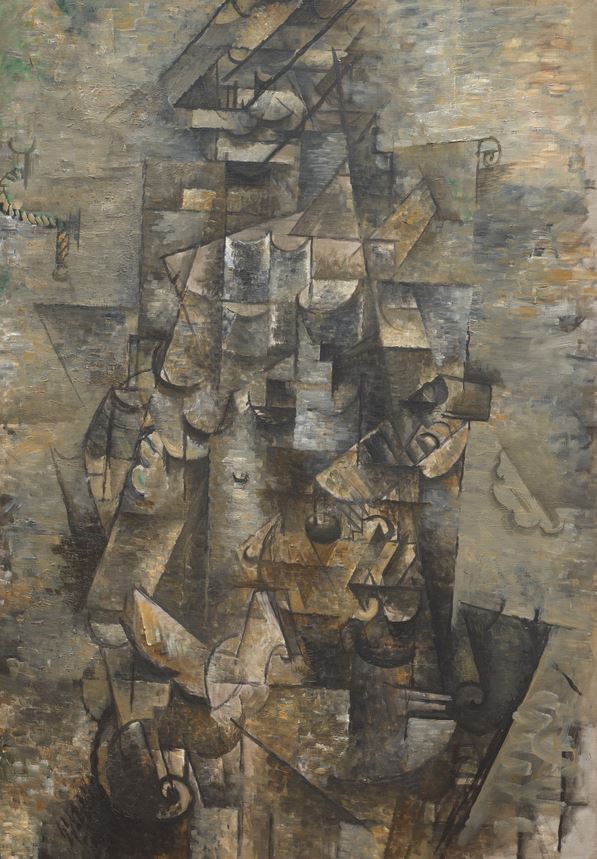
Georges Braque was among the almost well known artists who worked in the niche of Analytic Cubism. The art movement originated in the early on 20th century cheers to works such as Human with a Guitar, which is said to be among the most influential pieces of cubism washed by Braque.
Painted in 1912, the figure of a human and his guitar is noted by many art critics and enthusiasts every bit being barely recognizable. Still, those who appreciate the moving spatial aspects of cubism consider it to exist a masterpiece that plays on the homo mind much like the way a musician would strum a guitar.
Braque sought to challenge the long-held view that art must adhere to specific shapes and forms, presenting this work as one that challenges the viewer to brand sense of the loosely-held shades, angles, and minute details.
Many who look upon this piece of work past Braque note that it seems to be always-shifting before their eyes, demanding that each attribute be thoroughly inspected to attain the meaning of his work.
7. Tea Time – Jean Metzinger
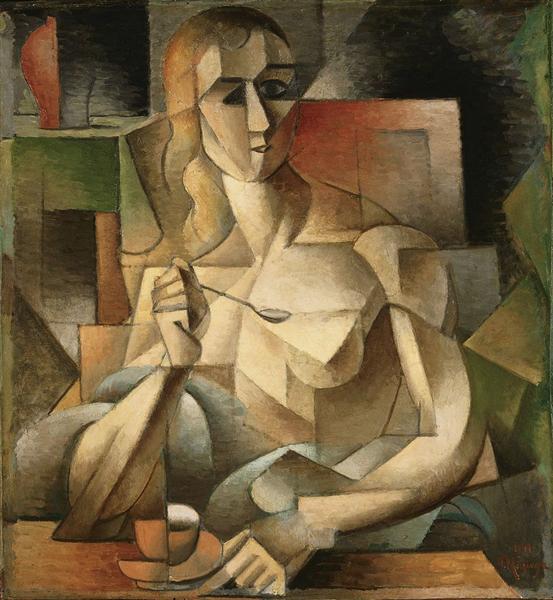
Jean Metzinger is among the most famous artists in cubism for her power to create some of the most iconic paintings associated with the genre. When her cubist portrait titled Tea Time was get-go displayed, it was dubbed by some of the near well-known critics of the solar day as "The Mona Lisa of Cubism."
While other artists in the world of cubism were venturing farther into the depths of evanescence, Metzinger sought to bring new levels of realism to the humming style that had become so pop through the early 20th century.
Metzinger finds a surprising level of anatomic realism despite the painting being fabricated upward of irregular shapes and angles. The subtle employ of shades and soft colors create more focus upon the nude female figure, who is seen gazing back at the viewer as she casually sips her teacup.
8. Still Life with Flowers – Juan Gris
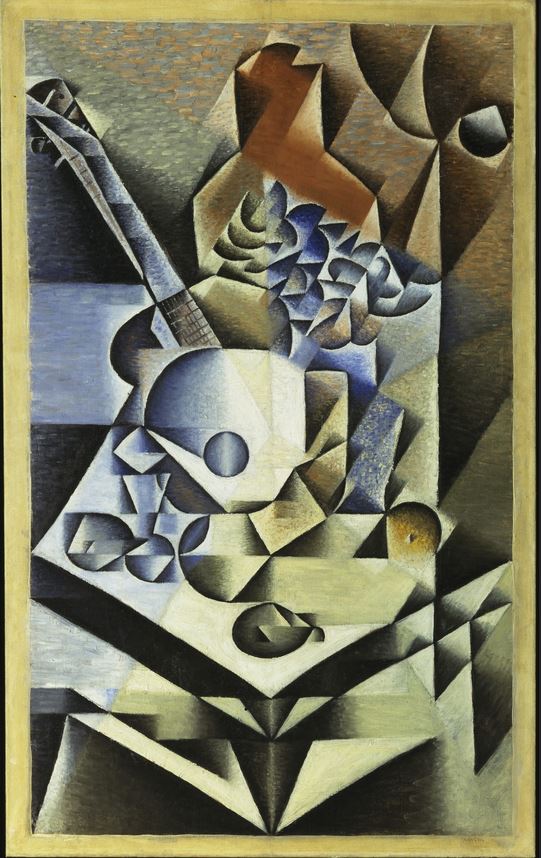
Juan Gris was hailed as one of the greatest artists in the cubism style for his power to mend symmetrical shapes and figures with those that were ofttimes in sharp contrast to the outline of his subjects.
Gris' work titled Still Life with Flowers was completed in 1912, during the meridian of the cubism era, and depicts a glowing and vibrant scene of flowers surrounding a stringed musical instrument.
This painting was recognized for Gris' stylistic use of triangles and overlapping planes that combine to form a scene of tranquillity and apprehensive beauty. This work is amidst his nearly famous as information technology features the brilliant combination of colors the artist had go known for during his career.
9. The Conquest of Air – Robert de la Fresnaye
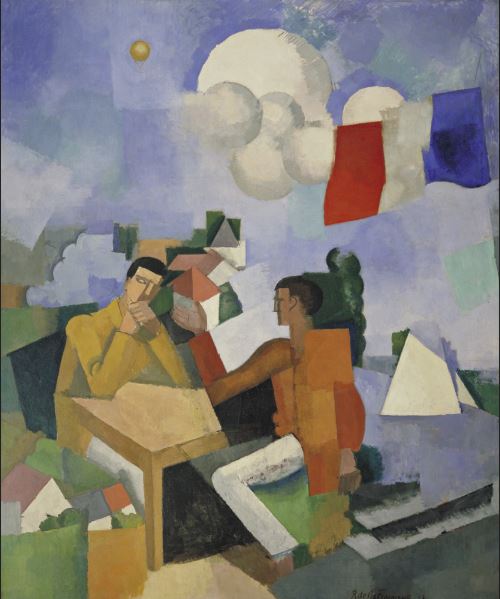
Robert de la Fresnaye painted i of the most memorable cubist works, specially amongst French artists during the time, in 1913. Titled The Conquest of Air, this painting seemed to play upon the expectation that each natural element somehow adheres to a subtle aspect of geometric perfection. The clouds are made up of circular spheres while the ground is depicted every bit having sharp, somewhat triangular qualities.
De la Fresnaye was heavily influenced past his studies involving the golden ratio and how mathematical proportions play into the advent of everyday scenes such as the one depicted in his painting.
This painting seems to blend elements of perfection with imperfection in a way that portrays an even combination of homo made and natural beauty.
10. Ma Jolie – Pablo Picasso
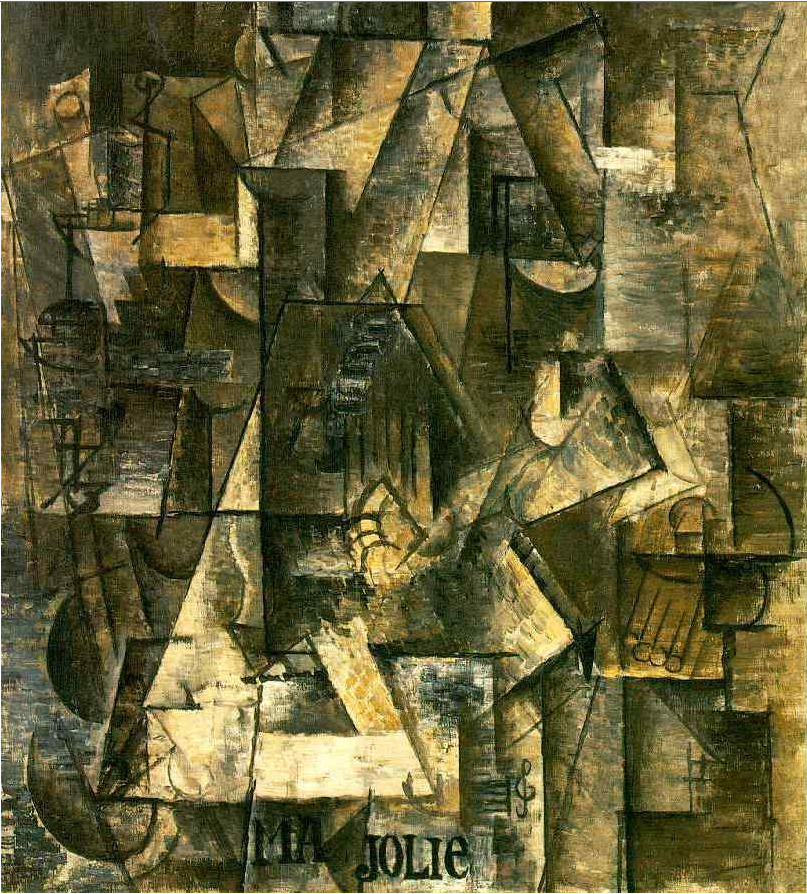
Pablo Picasso is among the near famous cubist artists as he was hailed for his ability to present objects and figures in seemingly solid forms, as well every bit masterpieces that play on the unreal nature of de-materialization.
His piece of work titled Ma Jolie, painted in 1911, boldly depicts his lover, Marcelle Humbert.
Ma Jolie, meaning "my pretty one," was said by Picasso to reference a popular music-hall song from the era while the true pregnant was held dorsum, only known to those shut to his circle of friends.
The irregular shapes and dark, stagnant colors seem to convey a deeper meaning as the cardinal figure all but disappears into the depths of abstract planes and subtle details.
We hope you accept enjoyed this list of famous cubist paintings!
pullenwhippyraton1972.blogspot.com
Source: https://www.artst.org/cubist-paintings/
0 Response to "10 Most Famous Cubist Paintings"
Post a Comment